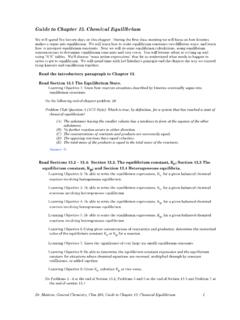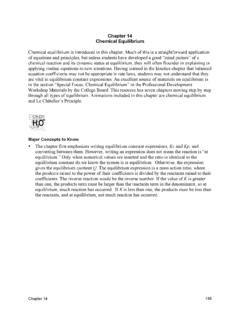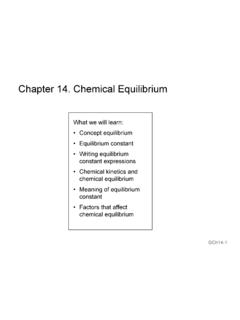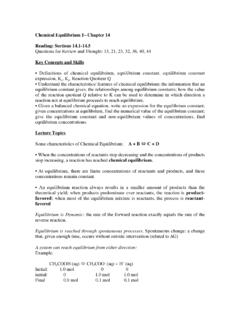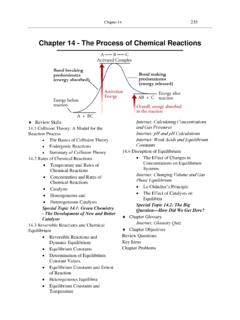Transcription of Chapter 15: Chemical Equilibrium - Seattle Central …
1 CHEM 162: Chapter 15 page 1 of 27 Chapter 15: Chemical Equilibrium : How Much Product Does a Reaction Really Make? End-of- Chapter Problems: , , , , Example: Ice melting is a dynamic process: H2O(s) H2O(l) Under normal atmospheric conditions this occurs at what temperatures? _____ Ex. 2 If a glass at room temperature is filled with ice cubes then water is added, can the reverse process occur? Explain. Ex. 3 Enough ice cubes are added to half fill each of three plastic jars then enough water is added to cover the ice cubes. Each jar is capped to be airtight.
2 The first jar is placed in a refrigerator set at 38 F, the second in a freezer set at 0 F, and the third in a refrigerator set at 32 F. Explain what you expect to find in each jar after 24 hours. 1. The jar kept at 38 F 2. The jar kept at 0 F 3. The jar kept at 32 F Reactants are not always converted to products in a Chemical reaction. When carrying out stoichiometry problems ( Calculate the mass of hydrogen gas produced when .. ), we have assumed that reactions always proceed to completion. In reality this is not always the case. Depending on the reaction and the conditions, 1.
3 In some reactions, all the reactants are converted to products. The reaction proceeds essentially to completion. The final composition consists mainly of products. 2. In some reactions, very little of the reactants are converted to products. The reaction occurs only to a slight extent. The final composition consists mainly of reactants. 3. In some reactions, some of the reactants are converted to products. The reaction stops short of completion. The final composition consists of appreciable amounts of reactants and products. CHEM 162: Chapter 15 page 2 of 27 Case #1: a.
4 Complete the following: HCl(aq) + NaOH(aq) b. When mL of hydrochloric acid are added to a flask containing mL of sodium hydroxide, The limiting reactant=_____, and the reactant in excess=_____. c. Using phenolphthalein, how can you show that this reaction proceeds to completion , only products and the reactant in excess are present after the reagents mix? Case #2: About 95% of dry eggshells consist of calcium carbonate, which decomposes as follows, CaCO3(s) CaO(s) + CO2(g) Given how quickly eggshells decompose at room temperature or even refrigerated temperatures, to what extent does this reaction occur at these temperatures?
5 Case #3: Consider the following reaction between the hexaaquacobalt(II) ion and chloride ion to form the tetrachlorocobalt(II) ion: [Co(H2O)6]2+(aq) + 4 Cl-(aq) CoCl42-(aq) + 6 H2O(l) pink blue At room temperature the Equilibrium mixture is purple. To what extent does the reaction occur? Explain. In both the ice-water mixture and the examples above, some or all of the reactants react to form products, and when enough products form, the reverse reaction occurs.
6 These are examples of reversible reactions , both the forward and reverse reactions take place. Because the ice-water mixture and the reactions in Cases #2 and #3 above do not always go to completion, they are more correctly represented using a double-arrow (): H2O(l) H2O(s) CaCO3(s) CaO(s) + CO2(g) [Co(H2O)6]2+(aq) + 4 Cl-(aq) CoCl42-(aq) + 6 H2O(l) CHEM 162: Chapter 15 page 3 of 27 THE DYNAMICS OF Chemical Equilibrium vaporization: liquid gas From a molecular viewpoint, a molecule escapes from the liquid state to the gaseous state As the liquid evaporates, more molecules go into the gas phase.
7 Vapor: The gas above a liquid when the liquid and gaseous states are both present vaporization: liquid + heat vapor condensation: vapor liquid + heat Liquid-Gas Equilibrium : liquid + heat oncondensati onvaporizati vapor When the molecules in the liquid have enough energy, they escape to the gas phase. In a closed system, when enough vapor exists above the liquid, some gaseous molecules condense back to the liquid. Ultimately, the rate of vaporization = the rate of condensation. The system has reached a state of dynamic Equilibrium in which the forward process occurs at the same rate as the reverse process.
8 In an open system, molecules in the liquid have enough energy to escape to the gas phase and continue to escape in a process called evaporation. What is Chemical Equilibrium ? TED ED talk - George Zaidan and Charles Morton Any Chemical reaction in a closed vessel will eventually achieve Chemical Equilibrium a state in which the concentrations of all reactants and products remain constant with time. At Equilibrium , the rates of the forward and reverse reactions are equal. CHEM 162: Chapter 15 page 4 of 27 Example: Sulfuryl chloride decomposes as follows: SO2Cl2(g) SO2(g) + Cl2(g) The figures above show closed systems of SO2Cl2, SO2, and Cl2 at 375K.
9 Initially, only SO2Cl2 molecules are present. When heated, the SO2Cl2 decomposes, and all three molecules are present. Given enough time, the system achieves Equilibrium . Ex. 1: Using the figures above, indicate the number of SO2, Cl2, and SO2Cl2 molecules at Equilibrium at 375K. _____ SO2Cl2 molecules _____ SO2 molecules _____ Cl2 molecules Ex. 2 : Indicate the number of SO2, Cl2, and SO2Cl2 molecules present 15 minutes after the Equilibrium is initially achieved at the same temperature. _____ SO2Cl2 molecules _____ SO2 molecules _____ Cl2 molecules Ex.
10 3 : If 9 SO2 molecules and 9 Cl2 molecules are placed in an empty container like those above, the container is closed, and the system once again achieves Equilibrium at 375K, indicate the number of SO2, Cl2, and SO2Cl2 molecules present at Equilibrium . _____ SO2Cl2 molecules _____ SO2 molecules _____ Cl2 molecules Ex. 4 : In another experiment 9 SO2Cl2 are placed in an empty container like those described above and the container is closed. The system once again achieves Equilibrium at 375K. Indicate the number of SO2, Cl2, and SO2Cl2 molecules present at Equilibrium .

